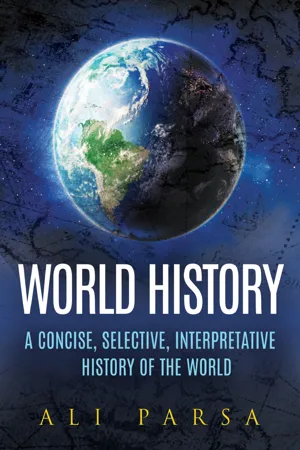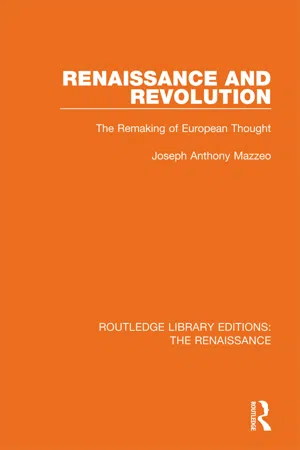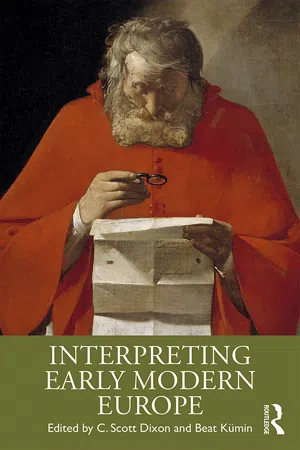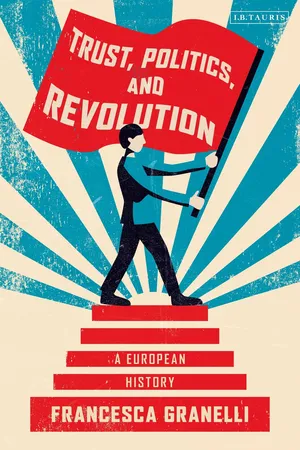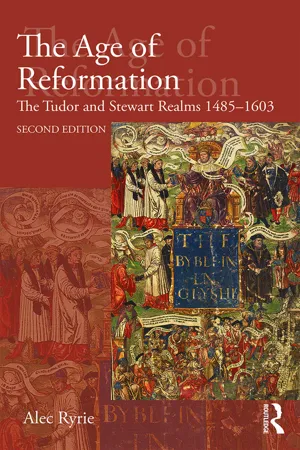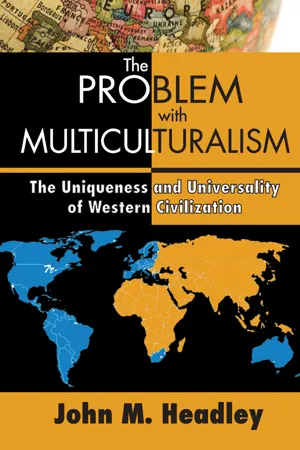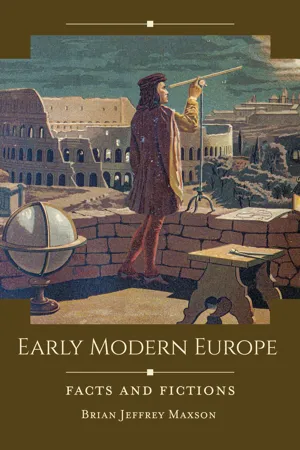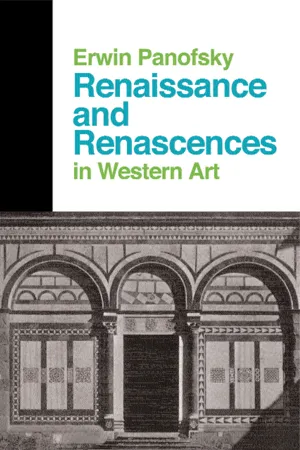History
European Renaissance
The European Renaissance was a period of cultural, artistic, and intellectual rebirth that took place in Europe from the 14th to the 17th century. It marked a transition from the medieval to the modern world and saw a revival of interest in classical learning, humanism, and the arts. The Renaissance had a profound impact on literature, philosophy, science, and the visual arts.
Written by Perlego with AI-assistance
Related key terms
11 Key excerpts on "European Renaissance"
- eBook - ePub
World History
A Concise, Selective, Interpretive History of the World
- Ali Parsa(Author)
- 2017(Publication Date)
- Sentia Publishing(Publisher)
Now, let us get started with the discussion of the European Renaissance. At the outset, I must clarify one of the most common misunderstandings of what Renaissance means. Most people associate the term Renaissance mainly with fantastic art, paintings, and architecture produced by great masters, such as Michelangelo, Rafael, and da Vinci. But in reality, the Renaissance was a much broader intellectual-humanistic transformation that changed the whole worldview of Western Europeans and subsequently the whole world. Art and architecture, as beautiful and publicly enjoyed and appreciated as they are, are only the products of a much bigger change.Renaissance means rebirth. Something must die in order to be born again. That one thing, according to the people who invented the term in the fifteenth century, was the glorious classic era of the Greco-Roman times, before the fall of Rome in the fifth century, when human beings were valued and creativity was rewarded. Out of the ashes of the Late Middle Ages, which were dominated by dogmatism and otherworldliness, a new focus on human beings began.The Renaissance HumanismA good way of understanding the essence of the Renaissance is to break it down into its three major aspects. The first aspect of the Renaissance, as it is most easily understood, is the yearning for the classics. It is not surprising that the Italians, who considered themselves to be descendants of and successors to the great Roman civilization, would be the pioneers of this movement. The father of Renaissance humanism is Francesco Petrarch. Although Italians had become wealthy through international maritime trade, they were politically divided. Feudalism, as had been developed in the rest of Europe, was not as strong in Italy. Instead, an urban economy with a growing middle class was taking shape. Petrarch, who was an erudite man, well versed in classical Latin and possessing a great knowledge of history, should be credited as the first person who tried to awaken the Italians to their glorious past in which human beings were valued and individuals were respected. - eBook - ePub
Renaissance and Revolution
The Remaking of European Thought
- Joseph Anthony Mazzeo(Author)
- 2019(Publication Date)
- Routledge(Publisher)
IRenaissance and Humanism The New EducationThe category of the Renaissance in historical thought is an ambiguous one. There are as many interpretations of the period as there are patterns of history or social, political, and cultural ideals. There is a pagan Renaissance and a Christian one, a Renaissance which liberated the individual from the coercive collectivities of the Middle Ages, and a Renaissance which drowned him in all the confusions and complexities of modern civilization. It has been pushed back in time, and we now have a twelfth-century Renaissance, one in the eleventh century, and even a ninth-century Carolingian Renaissance.The tendency to medievalize the Renaissance or, what amounts to the same thing, to push it further and further back into the Middle Ages, was not very widespread among scholars until the decades just before and after World War I, and it typified a good deal of Renaissance scholarship until the opening of World War II, when embattled nations found other, less innocuous, pursuits for scholars than restructuring the past.1However much the term may have been criticized, no one has quite been able to dispense with it since it was first introduced to describe a general historical period by Michelet in the seventh volume of his Histoire de France (1855). Five years later Jacob Burckhardt used it in the title of his famous study, Die Kultur der Renaissance in Italien, and it has since formed part of the intellectual equipment of educated men.The idea of a rebirth of the arts, or of letters and learning, goes back to the fourteenth century and was part of the consciousness of the very first generation of Renaissance humanists and artists. The term “Renaissance,” however, as used to refer to the totality of events occurring during a crucial period in the history of Europe, dates from the work of Michelet. The historiographical problem of the Renaissance derives from the widespread adoption of his generalized use of the term and the subsequent attempt to synchronize all the particular “rebirths” of one kind or another which presumably took place in this era. It is not difficult to detect the Hegelian Zeitgeist - eBook - ePub
- C. Scott Dixon, Beat Kümin(Authors)
- 2019(Publication Date)
- Routledge(Publisher)
4 Renaissance Edward Muir The interpretive challenge for Renaissance studies began in the nineteenth century, not the fourteenth, fifteenth, and sixteenth, the age of the Renaissance. Unlike the Enlightenment, no one living during the Renaissance knew about it. An ardent anti-clerical republican, Jules Michelet (1798–1874), popularised the term Renaissance (rebirth), and hence the French word still prevails in the English-speaking world in place of the Italian Rinascimento. A whiff of Michelet’s secular prejudices still lingers over the idea of the Renaissance. During the same period the Swiss Protestant, Jacob Burckhardt (1818–1897) wrote The Civilization of the Renaissance in Italy, which introduced art and cultural history as a pre-eminent means for understanding the period. Burckhardt’s innovative approach of Kulturgeschichte has been especially attractive because of his evocative portrait of how political illegitimacy produced artistic and intellectual vitality, epitomised by his famous phrase, ‘the state as a work of art’ (1958, 21). The Prussian Georg Voigt (1827–1891) added to the interpretive mix the term ‘humanism’, designating a movement that began with Francesco Petrarca [Petrarch] (1304–1374), who popularised among intellectuals methods of critical philology rooted in classical Antiquity. From this influential trio, none Italian, came a remarkably tenacious paradigm that defined the Renaissance as a period that began in the fourteenth century in Italy in reaction to the alleged clerical domination of the Middle Ages and that was characterised by secularism, artistic and cultural creativity, and humanism (defined as the critical, historical methods of philology) - eBook - ePub
Trust, Politics and Revolution
A European History
- Francesca Granelli(Author)
- 2019(Publication Date)
- I.B. Tauris(Publisher)
7 Renaissance Man – A revolutionary? Florentine Renaissance (1330–1550)A period of transition, the Renaissance is considered a bridge between the medieval period and modernity, traditionally defined as an era of discovery, both geographically and scientifically, of the world and of man.1 Witness to a variety of ‘revolutions’ across many disciplines (including the arts, science and technology, religion, learning and communication, philosophy and politics, trade and finance), this period in European history often experienced turbulent social and political upheaval.2 There was a decline in the influence of the Church while the value and agency of man were deified as classical learning was revisited in a milieu of historical infatuation. This period, however, was not strictly ‘rational’ or ‘secular’, (and neither did a full-blown individualism emerge), ‘instead, [it] is characterised by the uneasy co-existence between traditional themes and the plurality of new approaches.’3 Rather than a break with the past, the Renaissance, in many respects, is part of an ‘uninterrupted series of scarcely perceptible improvements’ towards modernity,4 with many of its achievements tracing their roots to the Middle Ages and cross-cultural interactions with the East.5 - eBook - ePub
The Age of Reformation
The Tudor and Stewart Realms 1485-1603
- Alec Ryrie(Author)
- 2017(Publication Date)
- Routledge(Publisher)
This historical humility was overturned by the intellectual and cultural revolution which we call the Renaissance. The idea that a ‘rebirth’ of sorts was taking place was current in the sixteenth century, but ‘the Renaissance’ is a nineteenth-century label and should be treated with appropriate care. (So too should another term coined at the same time: the ‘Middle Ages’, dismissing a thousand years of European history as a barren interval.) Even if we are happy with the word, almost everything about it is unclear: what it was, where and when it happened, and how many of it there were. This confusion is itself characteristic of the Renaissance. This was a slippery, restless, rhetorical and questioning movement, bubbling with contradiction.The idea of renaissance was itself a splendidly medieval one: that learning, especially classical learning, should be reborn. By definition, a renaissance looks to the past. Historians have peppered the medieval period with renaissances, notably in the ninth and twelfth centuries: episodes in which scholarship revived and lost texts were rediscovered. The revival of learning in northern Italy in the fourteenth century was in some ways merely another such episode. The great Italian cities were wealthy enough to afford the luxury of scholarship, and their location – with access to the great monastic centres of western Europe, to the bleeding remnants of the Byzantine empire in the east, and to the hugely sophisticated scholarship of the Islamic world – gave their scholars rich pickings.The new ingredient in the mix was politics. Northern Italy was the no-man’s-land in the drawn-out struggle between the papacy and the Holy Roman Empire (an essentially German entity, despite its name). In this turbulent environment, a new kind of political structure emerged: the city-state, choosing to govern itself rather than trust in the flimsy protection of princes or bishops. Wealthy, unstable, aggressive and ferociously proud little republics sprang up: Siena, Pisa, Florence, Venice. City-states and republics were an innovation (that dangerous thing) in a continent wedded to the ideal of monarchy. But this innovation could draw on older models: the city-states of the ancient world, such as Athens and, above all, republican Rome. The Italians’ most important discovery, or rediscovery, was of the importance of rhetoric and persuasion in republican politics. The high Latin style and sublime oratory of Cicero became the summit of Italian republican virtue. If Italians were to defend their new and embattled liberties as Cicero had defended ancient Rome’s, they would need his skills. So would those who wished to dominate the maelstrom of Italian politics. - eBook - ePub
- George Adams(Author)
- 2017(Publication Date)
- Jovian Press(Publisher)
THE RENAISSANCE
..................WE HAVE NOW TRACED, AS resulting from the influence imparted by the crusades, great economic and political revolutions which changed the face of history, and brought the middle ages to a close so far as their influence reached. These two revolutions were hardly more than well under way when there began another, growing largely out of the conditions which they were producing, starting partly from the same general impulse which aided them, a revolution of even greater importance than they in its influence upon the characteristic features of our own time, if it is possible to measure the relative values of such movements—that intellectual and scientific transformation of Europe which we call the Revival of Learning, or the Renaissance.Each of these names expresses a great fact which was characteristic of the movement and which it is well to distinguish, the one from the other.There was a revival of learning. The conditions which prevailed in the earlier middle ages, and obscured the learning which the ancients had acquired, were changing rapidly, the effects of the Teutonic invasion were passing away. Conquerors and conquered had grown into a single people, and the descendants of the original Germans had reached the point where they could comprehend the highest results of the ancient civilization. New national languages had been formed, and literatures had begun, no longer ecclesiastical in authorship or theme but close to daily life. The stir of great events, and the contagion of new ideas in commerce and exploration and politics filled the air, and the horizon of men’s minds and interests was daily growing wider. It was impossible that many generations of these economic and political changes should go by before men began to realize that there lay behind them a most significant history, and that the men of the past had many things to teach them. When men became conscious of this the revival of learning began. - eBook - ePub
- Daniel Pipes(Author)
- 2017(Publication Date)
- Routledge(Publisher)
CHAPTER VIITHE RENAISSANCE AND HUMANISMI n the Middle Ages man’s energies were concentrated upon interior spiritual matters and were not sufficiently manifested in exterior forms. Yet the Middle Ages culminated in the Christian Renaissance which represents the highest point reached in the development of Western European culture. I am thinking of the mystical Renaissance of Italy, which comprehends the prophecies of Joachim of Floris, the saintliness of Saint Francis of Assisi and the genius of Dante. I likewise associate with it the paintings of Giotto and all the currents of earlier Italian art. Taken as a whole this is one of the most extraordinary moments in the spiritual culture of Western Europe. It also raised the problem of a purely Christian Renaissance, and laid the foundations of a purely Christian humanism which must be distinguished from the later humanism of modern history.This Christian humanism stands out above all other contributions of Western spiritual culture. The purpose behind the mediaeval religious culture was by its depth and universal aim perhaps the greatest in history. It was such also by the scope of its imagination and ideal, which aspired to establish the Kingdom of God on earth surpassing in beauty all that had ever been conceived, and which evidenced a partial return to Greek sources, since every regeneration implies a revival of the latter. But this grandiose design of religious culture was doomed to failure; and the mediaeval Kingdom of God was neither fulfilled nor could be fulfilled. The achievements of the Christian Renaissance were, however, as extraordinary as the saintliness of Saint Francis and the genius of Dante; but this creative spiritual experience only served to demonstrate that man could no longer pursue the path which had been laid down for him by the mediaeval consciousness. His further path led him away from mediaeval culture. It led him in another direction, towards another Renaissance, which was in many ways anti-Christian. - eBook - ePub
The Problem with Multiculturalism
The Uniqueness and Universality of Western Civilization
- John M. Headley(Author)
- 2017(Publication Date)
- Routledge(Publisher)
Two Early Tudor Lives, ed. Richard S. Sylvester and Davis P. Harding (New Haven, CT: Yale University Press, 1962), 216.3. Extraordinary and unique. The uniqueness of the Renaissance has been recently questioned by Jack Goody, Renaissances: The One or the Many? (Cambridge: Cambridge University Press, 2010). Taking a loose, popular understanding of the Renaissance, the author sees it as simply another period of intellectual agitation, one more cultural efflorescence in the life of a society. In justice to the author, he claims that such movements as the Renaissance and the Reformation can occur in any society distinguished by written texts—Islamic, Indian, or Chinese—and a propensity for looking back in time. This involves the relatively simple matter, as we are told somewhat dubiously, of the Muslim who can look back on the Koran or the Abbasid rebirth of Greek scientific literature from the ninth to the sixteenth century. Goody joins the multiculturalists in claiming that to think otherwise—to grant the European Renaissance a special status—is a manifestation of “arrogance” (54). Yet it is precisely this arrogance that is necessary in the interest of historical truth. Beneath the overriding unity of the Reformation and West with the Classical Roman imperial order is a basic national and urban diversity that adds to the complexity of the Western version of the Renaissance, whose variety, diversity, and richness of its reengagement with the historical past is momentous. The Gupta period for India (320–480 CE) or the Tang for China (618–907 CE) left no discernible mark on and gave no new direction to its respective civilization. Europe’s profoundly different structures were the distinguishing factor, as demonstrated by the cases of perspective (both technically and in art and literature) and printing, both invented outside Europe. Samuel Edgerton, in The Mirror, the Window, and the Telescope: How Renaissance Linear Perspective Changed Our Vision of the Universe (Ithaca, NY: Cornell University Press, 2009) confirmed his earlier judgment (rendered in hTe Renaissance Rediscovery of Linear Perspective - eBook - ePub
Early Modern Europe
Facts and Fictions
- Brian Jeffrey Maxson(Author)
- 2023(Publication Date)
- Bloomsbury Academic(Publisher)
Today, most historians argue that life had changed enough by the 1500s to warrant a different historical period. The Italian peninsula was a center—though not the only one—for changes like the printing press, cheaper paper, state consolidation, and transatlantic voyages, apart from changes in religion and philosophical and scientific thought, among many other things. Scholars of the Italian peninsula argue that developments continued and differed from those of the medieval period. The term “Renaissance” continues to be used by scholars studying Italy, especially around the period 1300–1600, but the term no longer carries its previous pejorative connotations and often is simply shorthand for those centuries. Some very recent scholars have attempted to once again imbue the term with period-changing connotations, but such efforts are controversial and still much debated among scholars.Ultimately, most historians today are much less interested in comparing different periods of time to the present and much more interested in understanding the past on its own terms. It has become clear that the concept of a “Renaissance” itself is indebted to writers from the early modern and even modern periods who had far different agendas and views of the world than people possess today. Leaving behind stale questions about periodization, scholars have unpacked how people from all walks of life lived and interacted with others. The best studies are able to show convincing analyses of past artifacts and documents to interpret how and why the lives and views of past peoples and changed over time, regardless of how similar or different those cultures, changes, and people were to ourselves.PRIMARY SOURCE DOCUMENTSOne of Peter Abelard’s most famous works, The Story of My Misfortunes, is a good example of a medieval autobiography, making any argument about “the birth of the individual” in the Italian Renaissance difficult to sustain. The most famous part of the work describes how Abelard fell in love with a student and the disastrous consequences that followed for both of them. In the excerpt below, Abelard summarizes the arguments that Héloïse, his student and lover, presented to him for why they should not marry, despite the recent birth of their son in secret at Abelard’s country estate. - eBook - ePub
- Erwin Panofsky(Author)
- 2018(Publication Date)
- Routledge(Publisher)
5This memorable process of self-realization ( realization in the double sense of "becoming aware" and "becoming real") has been described so often and so well that it would seem superfluous to summarize it once more were it not for the fact that the art historian, for whose benefit these notes are written, has a special stake in the matter. While the Renaissance produced his ancestors, the artistically-minded humanists and the humanistically-minded artists of the fourteenth, fifteenth and sixteenth centuries, these ancestors of his took an important part in shaping the concept of the Renaissance itself. And the specific significance and nature of their contribution deserves a brief re-examination.1As everyone knows, and as was recognized by his very contemporaries, the basic idea of a "revival under the influence of classical models" was conceived and formulated by Petrarch. Moved "beyond words" by the impression of the ruins of Rome and acutely aware of the contrast between a past the grandeur of which shone from the remnants of its art and literature as well as from the living memory of its institutions and a "deplorable" present that filled him with sorrow, indignation and contempt, he evolved a novel version of history. Where all the Christian thinkers before him had thought of it as a continuous development, beginning with the creation of the world and leading up to the writer's own lifetime, he saw it sharply divided into two periods, the classical and the "recent", the former comprising the historian antiquae , the latter the historiae novae . And where his forerunners had conceived of that continuous development as a steady progress from heathen darkness to the light that was Christ (whether His birth was held to mark the last of Daniel's "Four Monarchies", or the last of the "Six Ages" corresponding to the six days of Creation, or the last of the "Three Eras", the first before the Law, the second under the Law, the third under Grace), Petrarch interpreted the period in which the "name of Christ began to be celebrated in Rome and to be adored by the Roman emperors" as the beginning of a "dark" age of decay and obscuration, and the preceding period—for him simply the period of royal, republican and imperial Rome—as an age of glory and light. He had been born too soon, he felt, to see the new day which he felt was dawning; "for you, however", he addresses his famous poem, the Africa , composed in 1338, one year after his first visit to Rome, "for you, if you should long oudive me, as my soul hopes and wishes, there is perhaps a better age in store; this slumber of forgetfulness will not last forever. After the darkness has been dispelled, our grandsons will be able to walk back into the pure radiance of the past".1 - eBook - ePub
The Ascent of the West
From Prehistory Through the Renaissance
- Britannica Educational Publishing, Heather Campbell(Authors)
- 2010(Publication Date)
- Britannica Educational Publishing(Publisher)
Cities were also markets for culture. The resumption of urban growth in the second half of the 15th century coincided with the diffusion of Renaissance ideas and educational values. Humanism offered linguistic and rhetorical skills that were becoming indispensable for nobles and commoners seeking careers in diplomacy and government administration, while the Renaissance ideal of the perfect gentleman was a cultural style that had great appeal in this age of growing courtly refinement. At first many who wanted a humanist education went to Italy, and many foreign names appear on the rosters of the Italian universities. By the end of the century, however, such northern cities as London, Paris, Antwerp, and Augsburg were becoming centres of humanist activity rivaling Italy’s. The development of printing, by making books cheaper and more plentiful, also quickened the diffusion of humanism.A textbook convention, heavily armoured against truth by constant reiteration, states that northern humanism—i.e., humanism outside Italy—was essentially Christian in spirit and purpose, in contrast to the essentially secular nature of Italian humanism. In fact, however, the program of Christian humanism had been laid out by Italian humanists of the stamp of Lorenzo Valla, one of the founders of Classical philology, who showed how the critical methods used to study the Classics ought to be applied to problems of biblical exegesis and translation as well as church history. That this program only began to be carried out in the 16th century, particularly in the countries of northern Europe (and Spain), is a matter of chronology rather than of geography. In the 15th century, the necessary skills, particularly the knowledge of Greek, were possessed by a few scholars. A century later, Greek was a regular part of the humanist curriculum, and Hebrew was becoming much better known, particularly after Johannes Reuchlin published his Hebrew grammar in 1506. Here, too, printing was a crucial factor, for it made available a host of lexicographical and grammatical handbooks and allowed the establishment of normative biblical texts and the comparison of different versions of the Bible.
Index pages curate the most relevant extracts from our library of academic textbooks. They’ve been created using an in-house natural language model (NLM), each adding context and meaning to key research topics.
